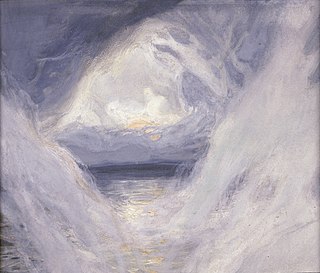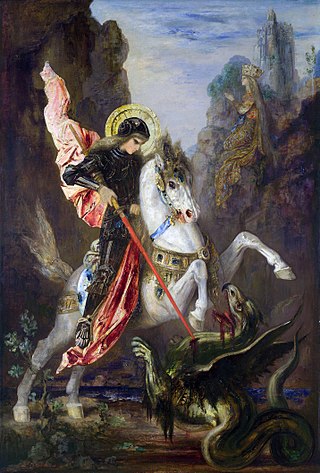
The Ainu are an ethnic group of related indigenous peoples native to northern Japan, including Hokkaido and Northeast Honshu, as well as the land surrounding the Sea of Okhotsk, such as Sakhalin, the Kuril Islands, the Kamchatka Peninsula, and the Khabarovsk Krai; they have occupied these areas known to them as "Ainu Mosir", since before the arrival of the modern Japanese and Russians. These regions are often referred to as Ezo (蝦夷) in historical Japanese texts.

A creation myth or cosmogonic myth is a type of cosmogony, a symbolic narrative of how the world began and how people first came to inhabit it. While in popular usage the term myth often refers to false or fanciful stories, members of cultures often ascribe varying degrees of truth to their creation myths. In the society in which it is told, a creation myth is usually regarded as conveying profound truths – metaphorically, symbolically, historically, or literally. They are commonly, although not always, considered cosmogonical myths – that is, they describe the ordering of the cosmos from a state of chaos or amorphousness.

Christian mythology is the body of myths associated with Christianity. The term encompasses a broad variety of legends and narratives, especially those considered sacred narratives. Mythological themes and elements occur throughout Christian literature, including recurring myths such as ascending a mountain, the axis mundi, myths of combat, descent into the Underworld, accounts of a dying-and-rising god, a flood myth, stories about the founding of a tribe or city, and myths about great heroes of the past, paradises, and self-sacrifice.
A creator deity or creator god is a deity responsible for the creation of the Earth, world, and universe in human religion and mythology. In monotheism, the single God is often also the creator. A number of monolatristic traditions separate a secondary creator from a primary transcendent being, identified as a primary creator.
The Bushongo or Songora are an ethnic group from the Congo River and surrounding areas. The creator god in Bushongo religion is called Bumba. Other names for him include M'Bombo and M'Bomba. He is said to have originally existed alone in darkness, in a universe consisting of nothing but primordial water. M'Bombo was said to appear like a gigantic man in form and white in colour. The creation took place when he vomited the sun, moon, animals and then humanity.
Yukar are Ainu sagas that form a long rich tradition of oral literature. In older periods, the epics were performed by both men and women; during the 19th and early 20th centuries, when Ainu culture was in decline, women were generally the most skillful performers. Traditional tales describe floating worlds with Ainu mosir, or the land of the humans, resting on the back of a fish whose movements cause earthquakes.

Ainu music is the musical tradition of the Ainu people of northern Japan. Ainu people have no indigenous system of writing, and so have traditionally inherited the folklore and the laws of their culture orally, often through music.
Tupã or Tupan is the word for God in the Tupi and Guarani languages, including the Guarani creation myth.

Ainu, or more precisely Hokkaido Ainu, is a language spoken by a few elderly members of the Ainu people on the northern Japanese island of Hokkaido. It is a member of the Ainu language family, itself considered a language family isolate with no academic consensus of origin. It is classified as Critically Endangered by the UNESCO Atlas of the World's Languages in Danger.
A kamuy is a spiritual or divine being in Ainu mythology, a term denoting a supernatural entity composed of or possessing spiritual energy.
Ae-oyna-kamuy (アエオイナカムイ) or Oyna-kamuy (オイナカムイ) for short is an Ainu kamuy (god) and culture hero. In Ainu mythology, he is credited with teaching humans domestic skills, and for this reason he is called Ainurakkur, and otherwise known as Okikurmi.
Kanda-koro-kamuy is the Ainu kamuy (god) of the sky. He is the prime originator of Ainu mythology, responsible either directly or indirectly for the creation of all things.
The Mandé creation narrative is the traditional creation myth of the Mandinka of southern Mali.
The Fon creation myth is the traditional creation story of the Fon peoples of West Africa. Various versions of the creation story are told. In most the creator is either Mawu, the moon being and mother of all the gods and humanity, or Mawu-Lisa, the sun/moon being who is both male and female. In others, Nana Buluku is the ultimate creator, an androgynous deity who gave birth to the female Mawu and the male Lisa and passed the power over creation to them.
The Tungusic creation myths are traditional stories of the creation of the world belonging to the Tungusic peoples of Siberia.

The creation of life from clay can be seen as a miraculous birth theme that appears throughout world religions and mythologies. It can also be seen as one of gods who craft humans out of earthly materials. As such, this class of story falls within a larger set of divine or cosmogonic origin stories about creation, whether through divine emergence or divine craft.
Kotan-kar-kamuy is the creator deity of the Ainu people. He should not be confused with god of the land Kotan-kor-kamuy, or the god of the sky Kandakoro Kamuy.
The mintuci is a water sprite or an aquatic supernatural creature, a half-man-half-beast, told in stories of Ainu mythology and folklore. It is also considered a variant of the kappa and therefore a type of yōkai.






